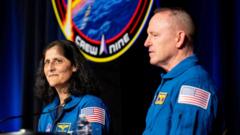
Starliner Mission Turns From Days to Months: A Technical Deep Dive
What was initially planned as an eight-day mission to the International Space Station (ISS) has unexpectedly transformed into a nine-month space odyssey for the crew of Boeing's Starliner spacecraft. Technical difficulties encountered shortly after launch have necessitated a significantly extended stay, prompting a reassessment of mission objectives and raising questions about the future of the Starliner program.
The Initial Promise: A Routine Crew Rotation
The Starliner mission was designed to perform a standard crew rotation, delivering personnel and supplies to the ISS. The spacecraft, Boeing's entry into the commercial crew program, aimed to provide a reliable and cost-effective means of accessing low Earth orbit. The initial eight-day schedule included docking with the ISS, conducting research, and returning safely to Earth. However, unforeseen circumstances quickly altered the course of the mission.
Technical Anomalies Force Extended Stay
Shortly after launch, a series of technical anomalies began to surface. These issues primarily revolved around the spacecraft's propulsion system and onboard software. While the exact nature of the problems remains under investigation, preliminary reports suggest a combination of valve malfunctions and software glitches contributed to the extended mission duration. NASA and Boeing engineers are working tirelessly to diagnose and resolve these issues remotely, ensuring the safety and well-being of the crew.
Impact on ISS Operations
The prolonged Starliner mission has had a ripple effect on operations aboard the International Space Station. The crew, now facing an extended stay, are adjusting their schedules to accommodate the altered circumstances. While the ISS is well-equipped to support long-duration missions, resource management and planning have become crucial. The extended mission also necessitates adjustments to future crew rotations and research schedules.
Key Challenges and Potential Solutions
Several key challenges have emerged as a result of the Starliner's technical difficulties. These include:
- Propulsion System Redundancy: Ensuring the reliability of the spacecraft's propulsion system for a safe return to Earth.
- Software Stability: Addressing and rectifying any software glitches that may impact navigation and control.
- Resource Management: Optimizing the use of onboard supplies and equipment to support the extended mission duration.
- Crew Well-being: Maintaining the physical and psychological health of the crew throughout the prolonged stay.
Potential solutions being explored by NASA and Boeing include:
- Remote Software Updates: Implementing software patches to address identified glitches and improve system performance.
- Ground-Based Support: Providing continuous monitoring and support from mission control to assist the crew in troubleshooting any issues.
- Contingency Planning: Developing detailed contingency plans for a variety of potential scenarios, including emergency return procedures.
- Crew Training: Providing the crew with additional training and resources to address the unique challenges of an extended mission.
The Future of the Starliner Program
The extended Starliner mission has raised questions about the future of the program and its role in supporting ISS operations. A thorough investigation into the root causes of the technical difficulties is essential to prevent similar issues from arising in future missions. The outcome of this investigation will undoubtedly influence Boeing's approach to spacecraft design, testing, and operational procedures.
The incident also highlights the inherent risks associated with spaceflight and the importance of rigorous testing and redundancy in critical systems. While setbacks are inevitable in the pursuit of space exploration, they also provide valuable learning opportunities that can inform future missions and advance our understanding of the universe.
Concluding Remarks
The nine-month Starliner mission serves as a reminder of the complexities and challenges of space exploration. While the initial plan has been drastically altered, the focus remains on ensuring the safety and well-being of the crew and utilizing the extended mission to gather valuable data and insights. The lessons learned from this experience will undoubtedly shape the future of the Starliner program and the broader landscape of commercial spaceflight.
```